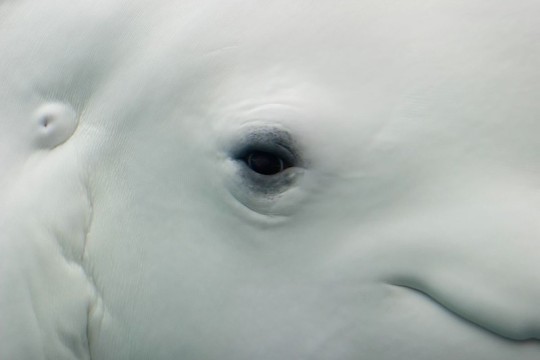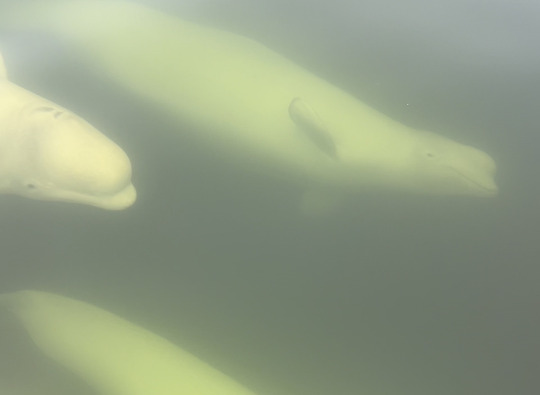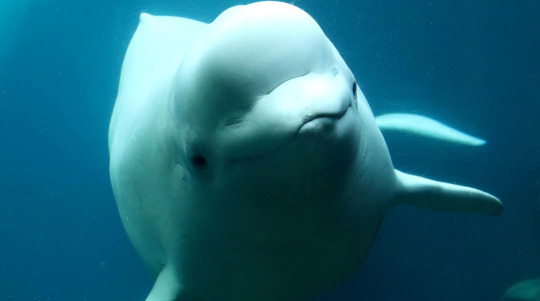#delphinapterus leucas
Text

The eye (and ear opening) of a Beluga whale (Delphinapterus leucas)
by Eric Heupel
#details#beluga whale#whales#cetaceans#delphinapterus leucas#delphinapterus#monodontidae#cetacea#artiodactyla#mammalia#chordata#captive animal#mystic aquarium
1K notes
·
View notes
Text

"Beluga whales" by Keyon aka Kirsten Dennis gouache on mixed media paper, 11x14"
#beluga#beluga whale#keyonsketches#kirstendennis#goauchepainting#goauche#original art#traditional painting#painting#Delphinapterus leucas#animal
38 notes
·
View notes
Text

Beluga Delphinapterus leucas
Observed by meggo_edgar, CC BY-NC
#Delphinapterus leucas#beluga#Cetacea#Monodontidae#cetacean#whale#North America#Canada#Manitoba#Arctic Ocean#Hudson Bay
22 notes
·
View notes
Text


How it started vs. How it's going
At first the narwhal swims on the outside of the group, trying to keep up with his new friends in unfamiliar waters.
When the same group of whales is spotted a year later, the narwhal swims in the middle of the group of belugas, now officially a permanent member of their pod!
From: Secrets of the Whales (2021) Episode 3: Beluga Kingdom
#beluga whale#delphinapterus leucas#narwhals#monodon monoceros#monodontidae#toothed whales#odontoceti#cetaceans#whales#🐋#i just think it's really cute they adopted him permanently ;-;#it was important for the researchers to see them again the next year to know for sure if he had been adopted long term!!#btw I think these might be the exact whales referenced in EAW!!!#extraordinary attorney woo#이상한 변호사 우영우
124 notes
·
View notes
Text
Still in awe that the vocalization organ in the forehead of cetaceans is called the melon. It’s so perfect. Nowhere is this more evident than in the squishiest motherfucker in the arctic circle: the beluga

Like, “Yep, that sure is a melon!”
29 notes
·
View notes
Text
In addition, hermaphrodite individuals occasionally occur in Belugas and possibly also in Sperm Whales. One Beluga, for example, had male external genitalia combined with a complete set of both male and female internal reproductive organs (i.e., two ovaries and two testes).
"Biological Exuberance: Animal Homosexuality and Natural Diversity" - Bruce Bagemihl
#book quote#biological exuberance#bruce bagemihl#nonfiction#hermaphrodite#intersex#beluga#beluga whale#delphinapterus leucas#sperm whale#physeter macrocephalus#reproductive organs
1 note
·
View note
Text
New beluga melon lore just dropped!!!!!
I'm so excited about the implications of this! One of the first ever recorded cases of cetaceans using facial expressions in social interactions!
And something that would have been pretty much impossible to study in wild populations!

Look at that funky melon action!!!!
40 notes
·
View notes
Text
Animal of the Day!
Beluga Whale (Delphinapterus leucas)

(Photo from Orlando News)
Conservation Status- Least Concern
Habitat- Arctic Ocean; Northern Pacific Ocean; Northern Atlantic Ocean
Size (Weight/Length)- 1360 kg; 5 m
Diet- Squid; Crustaceans; Octopus; Fish
Cool Facts- The sea canary that is the beluga whale will always put a smile on my face. With thick blubber to help survive freezing temperatures, the beluga’s most iconic feature is their melon head. Within their melon is an echolocation organ. By producing sounds that are more similar to a bird than a whale, beluga whales can find anything from schools of fish to breathing holes in meter thick ice. Belugas live in groups ranging anywhere from ten individuals to hundreds, including other species of whale and porpoise that are adopted into the pod. Constant play is a must. Belugas play catch with each other using wood and will pop bubbles that other belugas blow.
Rating- 13/10 (Not a whale, not a porpoise, more closely related to narwhals.)
Requested by @inewt
#Animal of the day#Animals#Mammals#Whales#Porpoise#Marine animals#Saturday#December 31#Beluga whale#biology#science#conservation#the more you know#new years eve#goodbye 2022#hello 2023
327 notes
·
View notes
Text
BIG FUCKING FISH 2 !!!!!!!!!!!!!!








beluga whale - delphinapterus leucas
112 notes
·
View notes
Text
After sharing the bird play vs tool use paper, a lot of people expressed interest in animal behaviour + play - I love cognition with a focus on play behaviour, which I feel is an aspect that is seriously undervalued by a lot of people.
Here's a misc list of some animal behaviour papers I enjoy with focus on play! (They should all theoretically be open access and available)
• Animal Play and Welfare by Suzanne D. E. Held & Marek Spinka
• Play Behavior in Crocodilians by Vladimir Dinets
• What is play fighting and what is it good for? by Sergio M. Pellis & Vivien C. Pellis
• Problem of reptile play: Environmental enrichment and play behavior in a captive Nile soft-shelled turtle, Trionyx triunguis by Gordon M. Burghardt, Brian Ward & Roger Rosscoe
• An Exploration of Play Behaviors in Raven Nestlings by Mathias Osvath, Helena Osvath, and Rasmus Bååth
• Play behavior in ectothermic vertebrates by Vladimir Dinets
• Adults Play but Not Like Their Young: The Frequency and Types of Play by Belugas (Delphinapterus leucas) in Human Care by Heather Hill & Domonique Ramirez
• On the Proximate Links Between Object Play and Tool Use in the Context of Stone Handling Behavior in Balinese Long-tailed Macaques by Camilla Cenni (Masters Thesis)
30 notes
·
View notes
Note
Do you enjoy getting facefucked, and do you swallow or spit?
The beluga whale (/bɪˈluːɡə/;[4] Delphinapterus leucas) is an Arctic and sub-Arctic cetacean. It is one of two members of the family Monodontidae, along with the narwhal, and the only member of the genus Delphinapterus. It is also known as the white whale, as it is the only cetacean to regularly occur with this colour; the sea canary, due to its high-pitched calls; and the melonhead, though that more commonly refers to the melon-headed whale, which is an oceanic dolphin.
21 notes
·
View notes
Text

Grzimek's Animal Life Encyclopedia, vol. 11, Mammals II. 1972. Illustrated by Peter Barrett.
Beaked whales;
1.) Baird's beaked whale (Berardius bairdii)
2.) Strap-toothed whale (Mesoplodon layardii)
3.) True's beaked whale (Mesoplodon mirus)
4.) Sowerby's beaked whale (Mesoplodon bidens)
5.) Northern bottlenose whale (Hyperoodon ampullatus)
White whales and narwhals;
6.) Beluga whale (Delphinapterus leucas)
7.) Narwhal (Monodon monoceros)
Long snouted dolphins;
8.) Rough-toothed dolphin (Steno bredanensis)
9.) Atlantic humpback dolphin (Sousa teuszii)
True dolphins;
10.) Indo-Pacific bottlenose dolphin (Tursiops aduncus)
11.) Common dolphin (Delphinus delphis)
12.) Striped dolphin (Stenella coeruleoalba)
13.) Atlantic white-sided dolphin (Lagenorhynchus acutus)
14.) Common bottlenose dolphin (Tursiops truncatus)
15.) Risso's dolphin (Grampus griseus)
16.) Northern right whale dolphin (Lissodelphis borealis)
Pilot and killer whales;
17.) Long-finned pilot whale (Globicephala melas)
18.) Pygmy killer whale (Feresa attenuata)
19.) Irrawaddy dolphin (Orcaella brevirostris)
20.) Orca (Orcinus orca)
21.) False killer whale (Pseudorca crassidens)
Commerson's dolphins;
22.) Commerson's dolphin (Cephalorhynchus commersonii)
Porpoises;
23.) Harbour porpoise (Phocoena phocoena)
24.) Spectacled porpoise (Phocoena dioptrica)
25.) Dall's porpoise (Phocoenoides dalli)
26.) Indo-Pacific finless porpoise (Neophocaena phocaenoides)
#cetaceans#beaked whales#baird's beaked whales#strap-toothed whales#true's beaked whales#sowerby's beaked whales#northern bottlenose whales#belugas#narwhals#dolphins#rough-toothed dolphins#atlantic humpback dolphins#indo-pacific bottlenose dolphins#common dolphins#striped dolphins#atlantic white-sided dolphins#common bottlenose dolphins#risso's dolphins#northern right whale dolphins#pilot whales#long-finned pilot whales#pygmy killer whales#irrawaddy dolphins#orcas#false killer whales#commerson's dolphins#porpoises#harbour porpoises#spectacled porpoises#dall's porpoises
267 notes
·
View notes
Photo

Beluga Whale (Delphinapterus leucas)
Family: Narwhal Family (Monodontidae)
IUCN Conservation Status: Least Concern
Easily distinguished from other whales due to its relatively small size, white colouration, round, blubbery head and lack of a dorsal fin (an adaptation that aids it when travelling under sea ice), the Beluga Whale is a species of whale native to Arctic and Sub-Arctic ocean regions. Also known as the Melonhead, Sea Canary, White Whale or simply Beluga, members of this species are found mainly in coastal waters surrounding Arctic regions of Asia, Europe and North America (although they have been known to spend prolonged periods of time in the open ocean), where they live in highly changeable pods of 2-25 individuals, with members joining and leaving the pod on a regular basis. Although they possess teeth Beluga Whales cannot chew, and so while their diet varies highly based on their location and the seasonal changes in the populations of prey they can only typically feed on animals that they can swallow whole through suction, such as worms, shrimps, crabs, bivalves, octopuses, squids and fish such as flatfishes, salmons, herrings and cod. Beluga Whales are capable of swimming beneath expanses of sea ice while using echolocation to find holes through which to surface for air, but when the sea ice spreads further and these holes become scarcer during the winter many populations migrate to the southern extremes of their range to spend the winter in relatively warm, ice-free bays and estuaries (as they do not typically stay with one pod for prolonged periods of time, it is believed that each individual Beluga Whale learns where to migrate to from their mother.) Beluga Whales breed largely in the spring and produce a single calf roughly every three years, with calves typically becoming independent at the end of this three year period. Oddly, newborn Beluga Whales are black or dark grey, and gradually transition to the white colouration of adults as they mature: it is thought that the dark colouration of a Beluga Whale calf helps it to blend in with murky water and avoid predators such as Orcas, but that as they grow larger this camouflage becomes less effective and as such they develop white colouration to allow them to camouflage against sea ice.
--------------------------------------------------------------------------
Animal Advent Calendar - Day 16
Image Source: https://www.inaturalist.org/taxa/41461-Delphinapterus-leucas
#December 16th#Beluga Whale#Whale#Whales#zoology#biology#mammalogy#marine biology#north american wildlife#asian wildlife#european wildlife#cetaceans#arctic wildlife#animal#animals#wildlife#mammal#mammals#marine mammals
31 notes
·
View notes
Text

Beluga Delphinapterus leucas
Observed by stevenhayward, CC BY-NC
#Delphinapterus leucas#beluga#Cetacea#Monodontidae#cetacean#whale#North America#Canada#Manitoba#Arctic Ocean#Hudson Bay
13 notes
·
View notes
Text
Happy world whale day 🐋🐬🐳💙
#sorry minke whales. you lost to gray whales bc theyre on money in mexico :]#baleen whales#toothed whales#odontoceti#mysticeti#cetaceans#whales#🐋
43 notes
·
View notes
Text
Facts of the Day: 🐋Beluga Whales🐋

Scientific Name: Delphinapterus leucas
Length: Up to 18 feet long
Weight: Up to 3,530 lbs
Lifespan: Up to 90 years
Reproduction: They mate in late winter or spring with a gestation period of 15 months. They give birth to one calf at a time, and then nurse the calf for two years. Due to this beluga whales breed every two to four years.
Diet: Fish, octopus, squid, crabs, shrimp, clams, snails, and sandworms.
Habitat: The Arctic Ocean, and it’s nearby surrounding waters in the Northern Hemisphere such as Alaska, Russia, Canada and Greenland.
Status: Endangered
Summary: Beluga Whales are highly social animals, nicknamed the “canaries of the ocean” for the variety of sounds they make to aid in echolocation for hunting prey. Every year, these whales will return to their birthplace to feed and reproduce, conglomerating in groups of several hundred whales during these seasons. While these whales do enjoy sticking in small groups outside of the breeding season, they seem to be able to move between pods, unlike Orcas which have strong ties with their maternal lead pods. Like with most whales, Beluga Whales are highly intelligent along with their social capabilities. They’re capable of swimming backwards, have an unfused vertebrae in their necks allowing them to turn their heads like humans, and have even been reported to mimic the sound of their human handler’s speech in captivity.
#baby shark bites!#sfw age regression#sfw regression#sfw agere#sfw age regressor#sfw petre#sfw pet regression#sfw pet regressor#Age Regression#Agere#age regressor#petre#pet regression#pet regressor#whale#beluga whale
13 notes
·
View notes